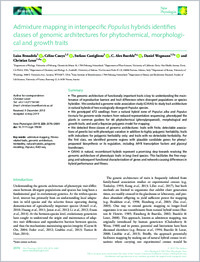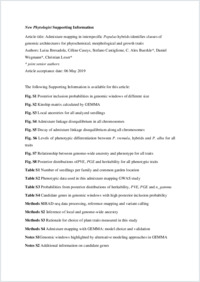Admixture mapping in interspecific Populus hybrids identifies classes of genomic architectures for phytochemical, morphological and growth traits
- Bresadola, Luisa Department of Biology University of Fribourg Chemin du Musée 10 1700 Fribourg Switzerland
- Caseys, Céline Department of Biology University of Fribourg Chemin du Musée 10 1700 Fribourg Switzerland - Department of Plant Sciences University of California Davis One Shields Avenue Davis CA 95616 USA
- Castiglione, Stefano Department of Chemistry and Biology ?A. Zambelli? University of Salerno Via Giovanni Paolo II 132 84084 Fisciano, Salerno Italy
- Buerkle, C. Alex Department of Botany University of Wyoming 1000 E. University Ave. Laramie WY82071 USA
- Wegmann, Daniel Department of Biology University of Fribourg Chemin du Musée 10 1700 Fribourg Switzerland - Swiss Institute of Bioinformatics 1700 Fribourg Switzerland
- Lexer, Christian Department of Biology University of Fribourg Chemin du Musée 10 1700 Fribourg Switzerland - Department of Botany and Biodiversity Research Faculty of Life Sciences University of Vienna Rennweg 12 A?1030 Vienna Austria
-
2019
Published in:
- New Phytologist. - 2019, vol. 223, no. 4, p. 2076–2089
English
The genomic architecture of functionally important traits is key to understanding the maintenance of reproductive barriers and trait differences when divergent populations or species hybridize. We conducted a genome-wide association study (GWAS) to study trait architecture in natural hybrids of two ecologically divergent Populus species. We genotyped 472 seedlings from a natural hybrid zone of Populus alba and Populus tremula for genome-wide markers from reduced representation sequencing, phenotyped the plants in common gardens for 46 phytochemical (phenylpropanoid), morphological and growth traits, and used a Bayesian polygenic model for mapping. We detected three classes of genomic architectures: traits with finite, detectable associations of genetic loci with phenotypic variation in addition to highly polygenic heritability; traits with indications for polygenic heritability only; and traits with no detectable heritability. For the first class, we identified genome regions with plausible candidate genes for phenylpropanoid biosynthesis or its regulation, including MYB transcription factors and glycosyl transferases. GWAS in natural, recombinant hybrids represent a promising step towards resolving the genomic architecture of phenotypic traits in long-lived species. This facilitates the fine-mapping and subsequent functional characterization of genes and networks causing differences in hybrid performance and fitness.
- Faculty
- Faculté des sciences et de médecine
- Department
- Département de Biologie
- Language
-
- English
- Classification
- Biological sciences
- License
-
License undefined
- Identifiers
-
- RERO DOC 327389
- DOI 10.1111/nph.15930
- Persistent URL
- https://folia.unifr.ch/unifr/documents/308154
Other files
Statistics
Document views: 122
File downloads:
- pdf: 162
- Supplementary material: 175
- Table S2: 60


